Villeroy & Boch Bundle
Who Really Owns Villeroy & Boch?
Unraveling the Villeroy & Boch SWOT Analysis is just the beginning; understanding its ownership is key to grasping its global influence. The recent acquisition of Ideal Standard in March 2024 dramatically altered Villeroy & Boch's trajectory, making its ownership structure more critical than ever. This exploration delves into the
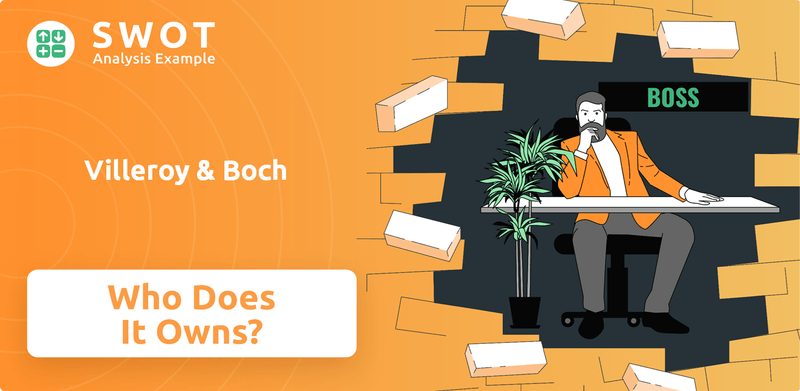
Founded in 1748, the
Who Founded Villeroy & Boch?
The story of Villeroy & Boch's ownership begins in the mid-18th century with two distinct family enterprises. François Boch, an iron master, laid the groundwork in 1748 with a pottery company. Later, Nicolas Villeroy established a faience manufactory, setting the stage for a significant merger.
The merger of these two entities in 1836 marked the official formation of Villeroy & Boch. This strategic move was crucial for competing in the European market. The union of the Boch and Villeroy families through marriage further solidified the company's foundation.
The early ownership structure of the V&B company was rooted in the founding families. While specific equity splits from the initial merger aren't available in public records, the combined resources and vision of the Boch and Villeroy families were key. The company's history, as detailed in Brief History of Villeroy & Boch, showcases how this partnership shaped the brand.
The early ownership of Villeroy & Boch was centered on the Boch and Villeroy families, who merged their businesses in 1836. This merger was a strategic move to compete in the European market. The families' combined resources and vision were instrumental in establishing the company.
- François Boch founded a pottery company in 1748, laying the groundwork for the future.
- Nicolas Villeroy established a faience manufactory, contributing to the eventual merger.
- The merger in 1836 created Villeroy & Boch, combining the strengths of both families.
- The company's early success was driven by the creative talent and entrepreneurial spirit of the founding families.
Villeroy & Boch SWOT Analysis
- Complete SWOT Breakdown
- Fully Customizable
- Editable in Excel & Word
- Professional Formatting
- Investor-Ready Format
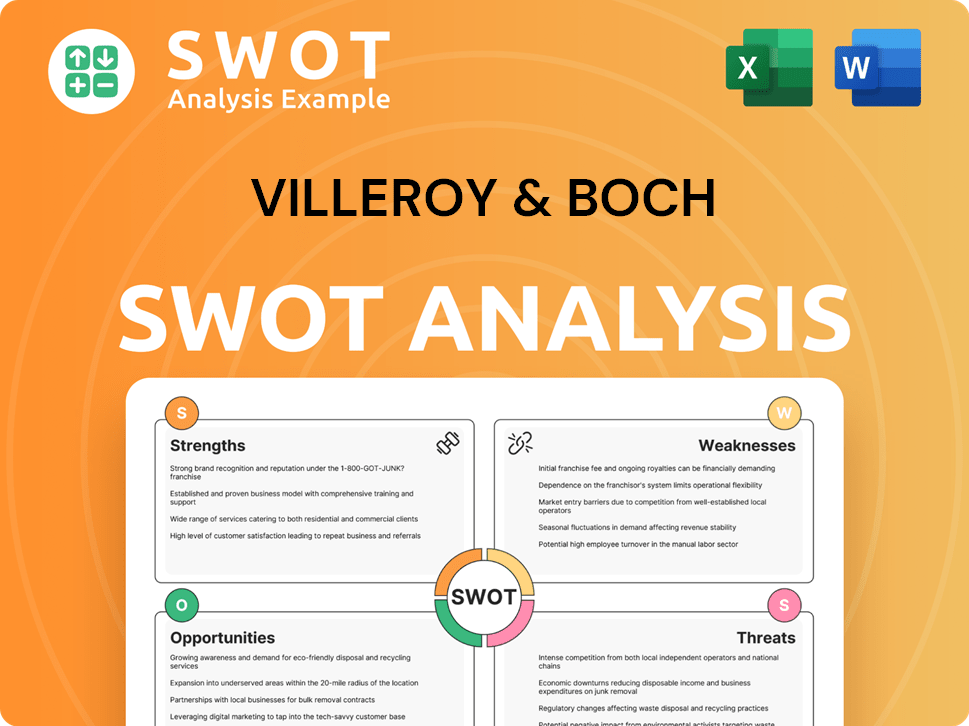
How Has Villeroy & Boch’s Ownership Changed Over Time?
The evolution of Villeroy & Boch's ownership structure reflects its journey from a family-run enterprise to a publicly traded company. Initially a family limited partnership, the company transitioned to a public limited company in May 1987. This move culminated in its listing on the Frankfurt Stock Exchange in 1990, opening the doors to capital markets and marking a significant shift in the company's ownership dynamics. The Villeroy & Boch brand has a rich history, and its ownership has evolved alongside its growth.
A key event that impacted the ownership structure was the sale of a majority stake in V&B Fliesen GmbH in 2007. While the company is publicly held, the Villeroy & Boch family has maintained a significant influence. The acquisition of Ideal Standard Group in March 2024, valued at €600 million, represents a major strategic move that has reshaped the company's market position and product portfolio. This acquisition was the largest transaction in Villeroy & Boch's history.
| Event | Date | Impact |
|---|---|---|
| Public Listing | 1990 | Opened to capital markets, broadened ownership. |
| Sale of V&B Fliesen GmbH Stake | 2007 | Altered ownership of a division. |
| Acquisition of Ideal Standard Group | March 2024 | Strengthened market position, diversified product portfolio. |
As of June 12, 2025, Villeroy & Boch AG has a market capitalization of $543 million with 26.7 million shares. Current major institutional shareholders include DFIEX - International Core Equity Portfolio - Institutional Class, Dfa Investment Trust Co - The Continental Small Company Series, and DFA INVESTMENT DIMENSIONS GROUP INC - International Vector Equity Portfolio Shares. The integration of Ideal Standard contributed €512.1 million to Villeroy & Boch's revenue from March 1, 2024, onwards. As of May 23, 2025, 18 institutional owners and shareholders have filed 13D/G or 13F forms with the SEC, holding a total of 129,249 shares.
Villeroy & Boch's ownership has evolved from family control to public ownership, with significant institutional investment.
- The Villeroy & Boch family has historically held considerable influence.
- The acquisition of Ideal Standard Group in March 2024 was a major strategic move.
- The company is publicly traded on the Frankfurt Stock Exchange.
- Institutional investors hold a significant number of shares.
Villeroy & Boch PESTLE Analysis
- Covers All 6 PESTLE Categories
- No Research Needed – Save Hours of Work
- Built by Experts, Trusted by Consultants
- Instant Download, Ready to Use
- 100% Editable, Fully Customizable
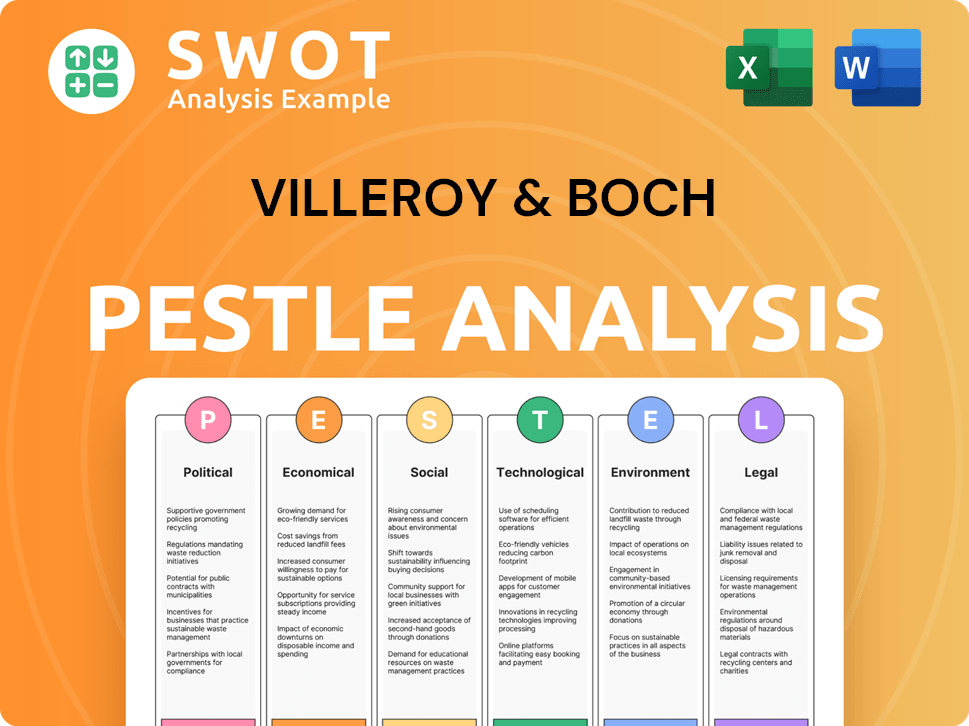
Who Sits on Villeroy & Boch’s Board?
As of May 2025, the leadership of the V&B company includes Gabi Schupp as CEO, who took over on January 1, 2024. Dr. Markus Warncke serves as the Director of Finance (CFO), and Georg Hermann Lörz is a Corporate Officer, also holding the role of Chief Operations Officer Bathroom & Wellness (COO B&W) since August 1, 2024. This management team steers the operations of this well-known brand.
The Supervisory Board, as detailed in the 2024 Annual Report, is led by Andreas Schmid as Chairman, whose term ends in 2025. Bärbel Werwie serves as the First Vice Chairwoman, with a term ending in 2028, and Dominique Villeroy de Galhau as Second Vice Chairman, also with a term ending in 2025. Other members include Susanne Heckelsberger, Susanne Ollmann, Christina Rosenberg, and Thomas Scherer. Louis de Schorlemer represents the shareholders. Understanding the Target Market of Villeroy & Boch can provide additional context to the company's strategic direction.
| Role | Name | Term End |
|---|---|---|
| Chairman | Andreas Schmid | 2025 |
| First Vice Chairwoman | Bärbel Werwie | 2028 |
| Second Vice Chairman | Dominique Villeroy de Galhau | 2025 |
While specific details on dual-class shares are not widely available, the presence of family members on the Supervisory Board, such as Dominique Villeroy de Galhau, suggests continued family involvement. The company operates as a public limited company (Aktiengesellschaft), generally implying a one-share-one-vote principle for ordinary shares. No recent proxy battles or activist investor campaigns have been reported, indicating a relatively stable governance environment for this long-standing company. The current owner of Villeroy & Boch is not explicitly detailed in available public information.
The governance structure of Villeroy & Boch involves a Supervisory Board and a Management Board. The Supervisory Board oversees management, with family representation indicating ongoing influence. The company's structure as a public limited company suggests a standard one-share-one-vote system.
- Supervisory Board oversees management.
- Family members are involved in governance.
- One-share-one-vote principle is generally applied.
- Stable governance with no recent proxy battles.
Villeroy & Boch Business Model Canvas
- Complete 9-Block Business Model Canvas
- Effortlessly Communicate Your Business Strategy
- Investor-Ready BMC Format
- 100% Editable and Customizable
- Clear and Structured Layout
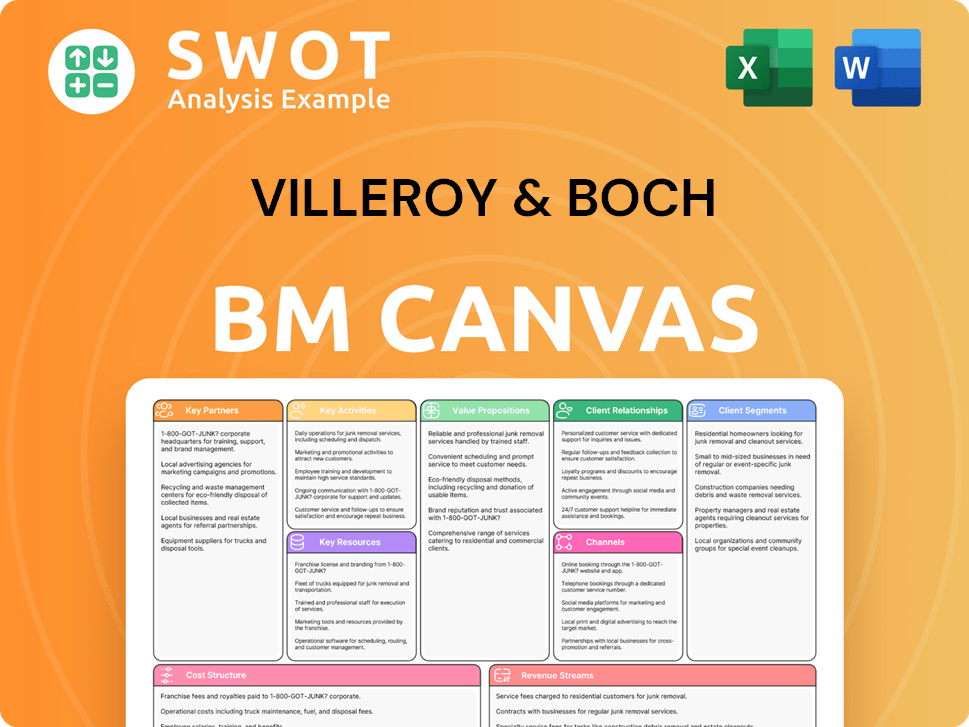
What Recent Changes Have Shaped Villeroy & Boch’s Ownership Landscape?
The most significant development in the Villeroy & Boch ownership profile over the past few years has been the acquisition of the Ideal Standard Group, finalized in March 2024. This strategic move has significantly reshaped the company, establishing it as a major player in the bathroom products market. The acquisition contributed €512.1 million to Villeroy & Boch's revenue from March 1, 2024, onwards.
This acquisition led to record revenue of €1.421 billion in 2024, a substantial 57.6% increase compared to the previous year. The integration of Ideal Standard aims to leverage synergies, enhance market resilience, and lay a strong foundation for future growth. The company anticipates continued revenue growth in the high single-digit percentage range and a moderate increase in operating EBIT for the 2025 financial year. For more insights into the competitive landscape, consider reading about the Competitors Landscape of Villeroy & Boch.
Leadership changes also marked a period of strategic reorientation, with Gabi Schupp assuming the role of CEO on January 1, 2024, succeeding Frank Göring. Simultaneously, investments in production site modernization and brand enhancement were made, totaling €58.3 million in property, plant, equipment, and intangible assets in 2024. These actions highlight the company's proactive approach to maintaining its market position and driving future growth.
The acquisition of the Ideal Standard Group in March 2024 was a major strategic move. This acquisition significantly increased Villeroy & Boch's market share and broadened its product offerings. It has positioned the company as a leading manufacturer in the bathroom industry.
The Ideal Standard acquisition contributed significantly to revenue. The company reported record revenue of €1.421 billion in 2024. The company anticipates continued revenue growth in the high single-digit percentage range for 2025.
Gabi Schupp became the CEO of Villeroy & Boch on January 1, 2024. This change represents a shift in the company's leadership. It also reflects the company's focus on strategic reorientation and market positioning.
Villeroy & Boch invested €58.3 million in property, plant, and equipment in 2024. The company is focused on modernizing production sites and enhancing its brand presence. It is also aiming for sustained growth.
Villeroy & Boch Porter's Five Forces Analysis
- Covers All 5 Competitive Forces in Detail
- Structured for Consultants, Students, and Founders
- 100% Editable in Microsoft Word & Excel
- Instant Digital Download – Use Immediately
- Compatible with Mac & PC – Fully Unlocked
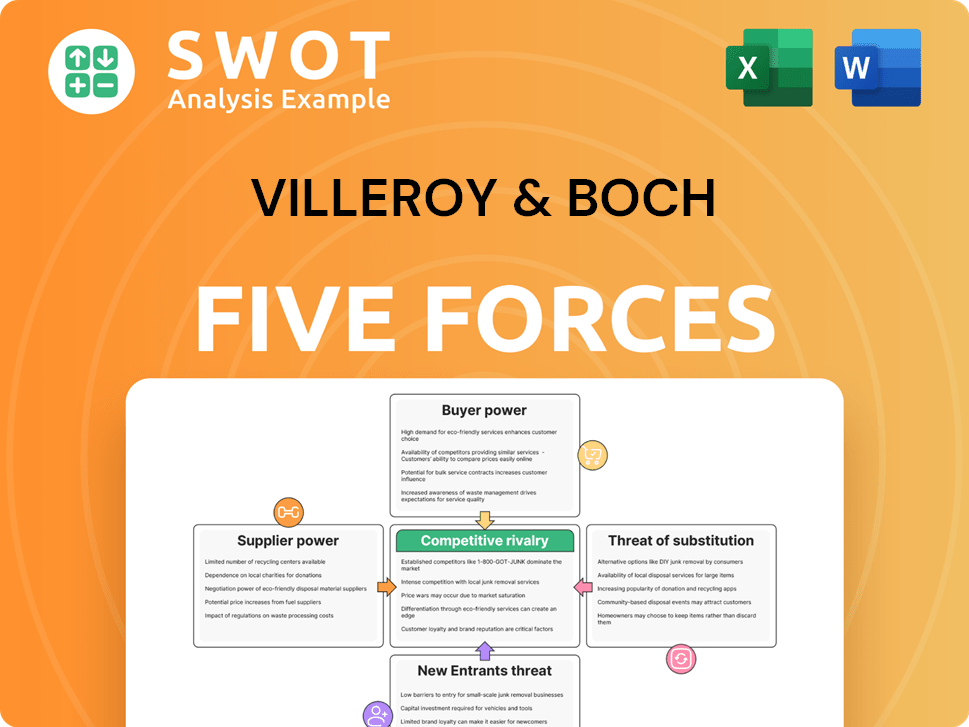
Related Blogs
- What are Mission Vision & Core Values of Villeroy & Boch Company?
- What is Competitive Landscape of Villeroy & Boch Company?
- What is Growth Strategy and Future Prospects of Villeroy & Boch Company?
- How Does Villeroy & Boch Company Work?
- What is Sales and Marketing Strategy of Villeroy & Boch Company?
- What is Brief History of Villeroy & Boch Company?
- What is Customer Demographics and Target Market of Villeroy & Boch Company?
Disclaimer
All information, articles, and product details provided on this website are for general informational and educational purposes only. We do not claim any ownership over, nor do we intend to infringe upon, any trademarks, copyrights, logos, brand names, or other intellectual property mentioned or depicted on this site. Such intellectual property remains the property of its respective owners, and any references here are made solely for identification or informational purposes, without implying any affiliation, endorsement, or partnership.
We make no representations or warranties, express or implied, regarding the accuracy, completeness, or suitability of any content or products presented. Nothing on this website should be construed as legal, tax, investment, financial, medical, or other professional advice. In addition, no part of this site—including articles or product references—constitutes a solicitation, recommendation, endorsement, advertisement, or offer to buy or sell any securities, franchises, or other financial instruments, particularly in jurisdictions where such activity would be unlawful.
All content is of a general nature and may not address the specific circumstances of any individual or entity. It is not a substitute for professional advice or services. Any actions you take based on the information provided here are strictly at your own risk. You accept full responsibility for any decisions or outcomes arising from your use of this website and agree to release us from any liability in connection with your use of, or reliance upon, the content or products found herein.